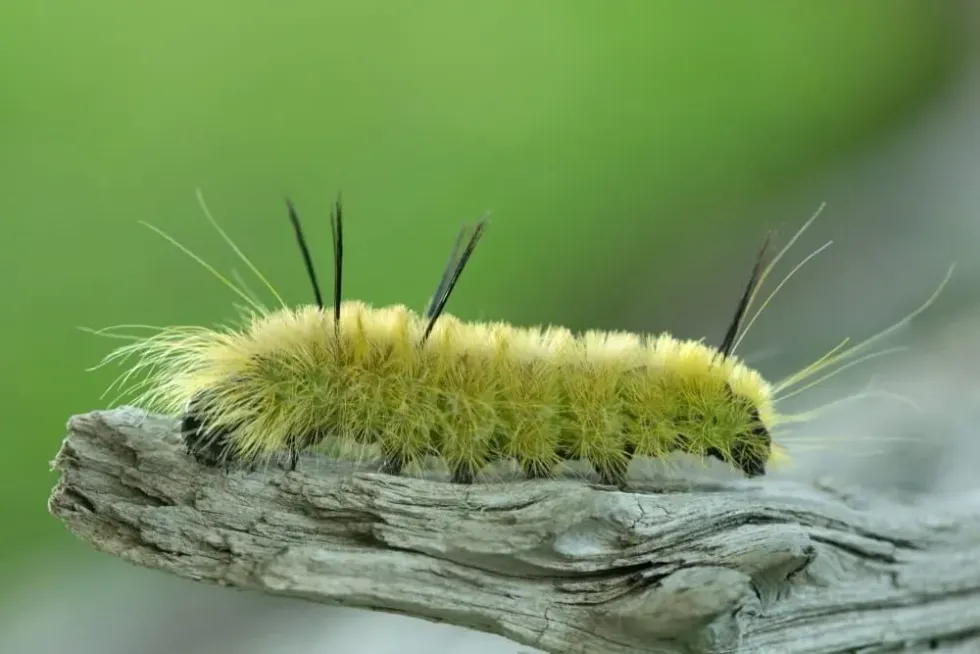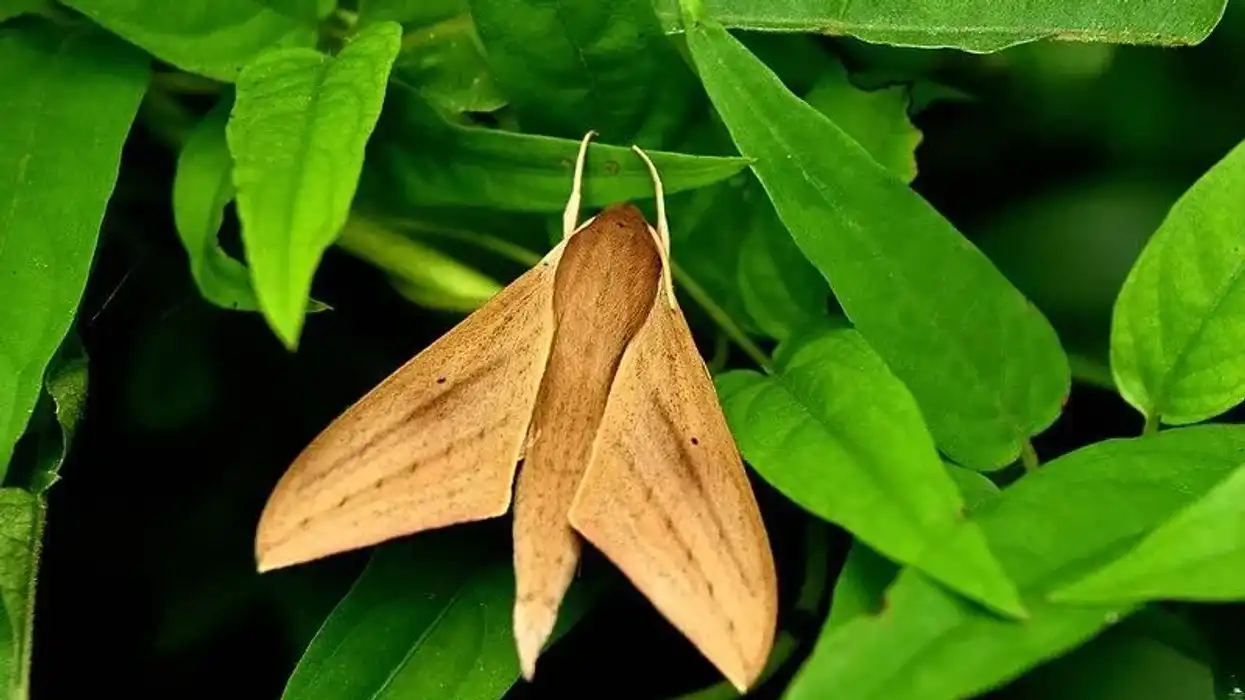Creepy crawlies can scare even the best of us! But if you are a brave person who is unafraid of caterpillars, moths, and their friends, then the American Dagger Moth is the perfect companion for you.
Endemic to North America, as is given by their name, they have a very short life span, growing from larvae to caterpillars with bright colored hair, to drab-colored adults to eventually finishing their life cycle.
However, just because they do not live long, that does not mean they do not live well. Named after the 'dagger' shape made by the black line on their wings, this species can be found very close to home.
This species is found East of the Rocky Mountains. They first came into light in the mid-1800s, when they injured the young son of an American naturalist.
Since then, it has existed around us, on trees such as the cedar, oak, and the willow, content to be where it is. However, if you ever see them in caterpillar form, leave them alone!
Touching their prickly hairs will result in you ending up in a nasty rash that won't go away for days to come. It is best to avoid them, and instead spend time reading about them with our facts collected for you below, and about other animals such as the puss moth and the purple emperor butterfly.
American Dagger Moth Interesting Facts
What type of animal is an American Dagger Moth?
The American Dagger Moth (Acronicta americana) is a type of moth.
What class of animal does an American Dagger Moth belong to?
The American Dagger Moth belongs to the phylum Arthropoda, also called the arthropod.
How many American Dagger Moths are there in the world?
Due to a lack of research, there is no fixed number of these drab-colored creatures across the world.
Where does an American Dagger Moth live?
The American Dagger Moth is primarily found in forests and near houses and other urban landscapes.
What is an American Dagger Moth's habitat?
The Dagger Moth has its habitat in deciduous trees such as cedar, oak, and more. They prefer areas with lots of trees, shrubs, hedges, bushes, and vegetation.
Who do American Dagger Moths live with?
The Dagger Moth mostly lives by itself.
How long does an American Dagger Moth live?
The American Dagger Moth lives up to three years.
How do they reproduce?
The female will lay eggs on the leaves of a tree, wherein the male will fertilize them soon after. The larvae are born less than 10 days after.
Larvae feed on tree sap, leaves, and more as they grow up to be the American Dagger Moth caterpillar, after which it transforms from an American Dagger Moth caterpillar to a full-fledged adult.
What is their conservation status?
The Dagger Moth has been marked by the IUCN list as a species of Least Concern.
American Dagger Moth Fun Facts
What do American Dagger Moths look like?
As adults, they have two forewings and back wings, colored a drab brown-black in shade. Females are darker in coloring, and both have a black band running through their wings. The caterpillars, on the other hand, have black and yellow setae that extended from their first and third abdominal segments.
How cute are they?
This species is not cute at all. They are very drab in color, with their black, brown shades and creepy crawly larvae. It is best to avoid these creatures at all times.
How do they communicate?
They primarily communicate through their antenna and scents which they use to navigate to mates, invite for mating, and lay eggs to be fertilized.
How big is an American Dagger Moth?
The American Dagger Moth is actually moderately sized, around 2-2.5 in. This makes them more than five times as large as the Stigmella Maya, the smallest moth in the world.
How fast can American Dagger Moths fly?
There is no recorded speed for how fast they can fly. However, they do fly around a lot, jumping from one tree to another.
How much does an American Dagger Moth weigh?
Coming in at a minuscule 0.005 g, the Dagger Moth weighs almost nothing.
What are their male and female names of the species?
There is no specific name for the male or the female of this species.
What would you call a baby American Dagger Moth?
You would call the baby an American Dagger Moth caterpillar.
What do they eat?
They are primarily herbivores, eating only tree leaves from trees such as oak, cedar, willow, and more. Occasionally, they will also consume tree sap if it is readily available.
Are they dangerous?
In their adult form, the American Dagger Moth poses no danger to anyone. However, the American Dagger Moth caterpillar can be quite dangerous. They can cause rashes, sores, and reddening. However, they are not fatal, nor are they venomous. Scientists are still investigating the reason for the rashes.
Would they make a good pet?
No. This is because not only are they poor pets, they are also difficult to maintain, and illegal to have as pets in the first place due to conservation concerns. You would be much better off adopting a cute puppy instead!
Did you know...
These species with black hairs and yellow bristles were discovered by Thaddeus William Harris in 1848 when his three-year-old son accidentally touched the yellow and black hairs and skin of the caterpillars in their gardens. He had them classified as caterpillars and their adult form in the order Lepidoptera.
Dangers of the American Dagger Moths to humans
The American Dagger Moth caterpillar is the only phase of its life when it is dangerous to humans. It has thin black bristles on its body along with yellow and white hairs of a different density.
Touching them may result in rashes, allergic reactions, sores, and more. It is best to drive away any caterpillars as soon as you see them. You can do this by brushing it away with a broom, and placing mint plants around your house and backyard to prevent their return.
The American Dagger Moth's life cycle
The American Dagger Moth life cycle is a short one. It takes ten days for caterpillars to emerge from larvae. After this, it takes another month for the American Dagger Moth caterpillar cocoon to form.
Before they emerge from their cocoon, they have yellow, white, and black bristles on their skin. Once adults, they seek to lay eggs and fertilize them, after which they die. Without mating, they can live up to three years.
Here at Kidadl, we have carefully created lots of interesting family-friendly animal facts for everyone to discover! Learn more about some other arthropods including morpho butterfly, or centipede.
You can even occupy yourself at home by drawing one on our American Dagger Moth coloring pages.










